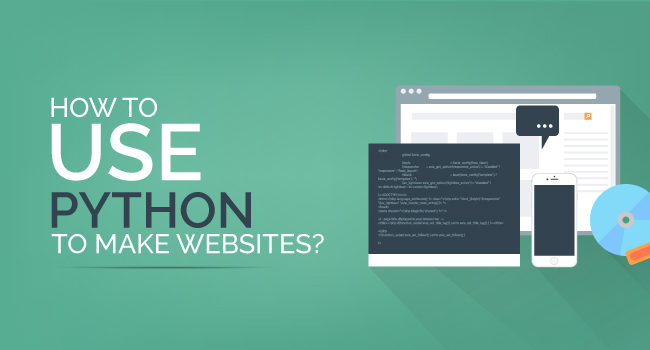Blog Category(283 Blogs)
How To Use Python To Make Websites?
If someone told you that you can build a website using Python by coding a program. He/she has no clue at all
You will not only be able to run your code on a web server but can accept page requests and offer responses in the form of HTML data. However, this calls for a lot of sweat from you.
But fret no more!
You can avoid all the strain by employing a host of user-friendly tools called Python frameworks that can be used to create a website.
A Sneak Peek into Various Python Web Frameworks
Python developers are familiar with a number of web frameworks that can be used to build websites. Django, Grok, WebPy, TurboGears, WebApp2, Pyramid, and Flask are some of the most widely used Python frameworks that can help you build a website from the scratch.
The Website Building Process – Broken Down Into Simple Steps
When it comes to building a website, it is very important that you start with the very small step. Once you taste success with simple applications, you will be skilled to move on to create a full-fledged and robust application. In doing so, every single step towards website development will be counted, serving as a yardstick for your progress.
Step 1:
The first step to build a website by coding in Python is to create an empty file. The empty file should then have the following code and saved with a .pyextension before running it.
The code is as follows:
from flask importFlask
app=Flask(__name__)
@app.route(‘/’)
def home():
return“Website content goes here.”
if __name__ ==’__main__’:
app.run(debug=True)
If you notice the commands, you will find that the code is employing the Flask framework. This is the code which takes the form of a web application prototype that is generated using Python.
Step 2:
The next step is to run this code by visiting localhost:5000. By doing this, you will be able to experience the first look of your website. Notwithstanding the fact that this looks like plain text in the first instance, you can still call it a website.
In case you don’t have the Flask framework, you can simply install it by keying in pip install flask at the terminal or command prompt. Going further, you will be employing Python functions to return an output to the source URL. But in reality, your purpose is to return HTML pages in contrast to plain Python strings.
Step 3:
To enable this, you are supposed to proceed with the following code in accordance with the render template method.
from flask importFlask, render_template
app=Flask(__name__)
@app.route(‘/’)
def home():
return render_template(“home.html”)
if __name__ ==’__main__’:
app.run(debug=True)
However, it goes without saying that you first need to create a home.html file which should be positioned inside a folder named templates. Care should be taken to create this folder at the same directory level as that of your Python file.
This is the simplest and systematic way to create a website using Python.
In an attempt to provide some functional guidance to create a website using Python, here are some useful tips that you can make use of:
- It is a wise move to run your website in a virtual environment. And to create a virtual environment, you can rely on the virtualenv library:
pip install virtualenvpython-m venvfoldername
-
You would want your HTML files to adhere to the CSS styling pattern. Given this requirement, you should create a folder called static in the same directory level as your templates folder. You should then create subfolders with filenames of CSS and JavaScript inside the folder to house the respective files. The next step is to link these files from the HTML pages by keying in this linking command:
<linkrel=”stylesheet”href=”{{ url_for(‘static’,filename=’css/main.css’) }}”>
-
Your aim to build a website using Python is still incomplete. Your ultimate goal is to mount your website online so that internet users can visit your website through a public website address. To do this, you can take the support of Heroku Cloud. First, you need to create a Heroku account to access its free hosting plan. After that, it is going to be a smooth ride to position your website. Making the most of certain tools like Git and Heroku Toolbelt, you will be in a favorable position to deploy your Python website.
-
The list of tips does not end here. Going by the maxim that it is “better to be safe than be sorry”, another useful point that demands a special mention is to set the debug parameter to “False”. This initiation should be done before the deployment process begins. This word of caution will go a long way in keeping your app safe and secure.
Benfits of using Python in Web Development
- Deployment time will be less compared to others
- Highly flexible
- Resources and libraries are in plenty
- Has got a Google App Engine
- Maintainable features can be incorporated swiftly
- powerful web development frameworks
- Data analytics libraries of Python are impeccable
For more info, click this
Closing Thoughts
As you have by now understood that Python can be used to build a website, it does not come as the only means. For a website to be functional, you will need a combination of HTML, CSS and JavaScript. All these elements will have to work in tandem with your Python code by responding to the requests and returning HTML, JavaScript and CSS. Since this is a herculean task, you can lean on the Python frameworks like Django and Flask to simplify your website building process.

 Python
Python Magento
Magento Odoo
Odoo How To
How To How Much
How Much Yii Development
Yii Development Core PHP
Core PHP Prestashop
Prestashop Latest News
Latest News Education
Education Web Design
Web Design Business
Business Ecommerce
Ecommerce Travel
Travel Banking and Finance
Banking and Finance Web Development
Web Development Ruby On Rails
Ruby On Rails Joomla Development
Joomla Development Ecommerce
Ecommerce Magento Development Services
Magento Development Services Hire a Developer
Hire a Developer Web Crawling Services
Web Crawling Services












